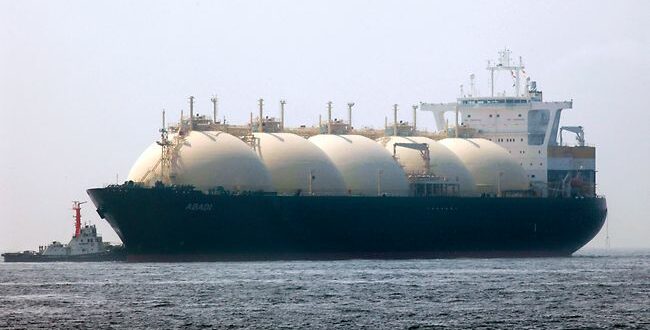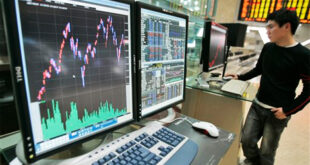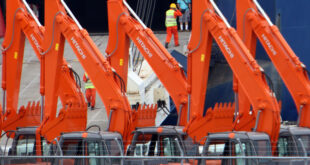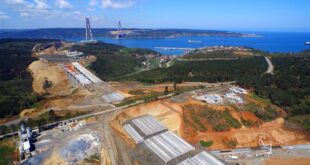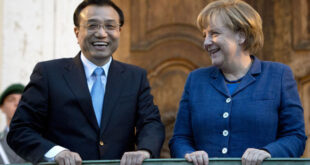Rates for tankers hauling liquefied natural gas are rising for a third year as expanding Japanese demand for the fuel attracts cargoes from the Atlantic, extending voyages at a time of shipping capacity shortages.
Rising requirements from Japan mean Golar LNG Ltd. (GOL), which operates nine LNG tankers and is controlled by shipping billionaire John Fredriksen, will report a threefold gain in 2012 net income, according to the mean of 11 analyst estimates in a Bloomberg survey. Golar is reactivating four-decade-old mothballed ships after rates doubled in 2011 and are forecast by analysts to advance another 58 percent in 2012.
Traders redirected 13 ships to Asia from Europe or the U.S. in the past month, data compiled by Bloomberg show. LNG from Nigeria, the largest exporter in the Atlantic, sold for 93 percent more in Japan than in the U.K. in January, up from 40 percent 11 months ago, according to New York-based Poten & Partners.
“This bottleneck cannot be corrected overnight,” said Fotis Giannakoulis, a New York-based analyst at the bank. “It will take years, and it is an opportunity for a lot of LNG shipowners to generate premium returns.”
Shipments to Japan, the biggest LNG buyer, are swelling to a record after March’s earthquake and tsunami shuttered about 90 percent of the nation’s nuclear power. Gaps between LNG prices around the world will last five more years because production is growing fastest in the Atlantic while demand is being led by Asia, Morgan Stanley estimates.
Oil Rout
LNG tanker rates rose to $97,630 a day last year from $43,663 in 2010, according to Fearnley LNG, a unit of Norway’s second-largest shipbroker. Daily rents will average $147,000 in 2012, the median of six analyst estimates compiled by Bloomberg shows. Costs surged as shipowners failed to keep pace with an expansion in the supply of LNG, liquefied by cooling natural gas to about minus 160 degrees Celsius (minus 256 degrees Fahrenheit).
Fredriksen, Golar’s 67-year-old chairman, is betting the rally won’t end any time soon. The company is spending $400 million on two new LNG carriers and may double the order because global price gaps and trade growth make the ships a good investment, according to a Feb. 14 statement.
Demand for LNG carriers will rise 12 percent this year, RS Platou Markets AS, an Oslo-based investment bank, estimates. Two new carriers will join the fleet of 374 ships, an expansion of less than 1 percent, according to London-based Clarkson Plc (CKN), the world’s largest shipbroker. The vessels need equipment to hold about 155,000 cubic meters (5.5 million cubic feet) of liquid that expands to 95 million cubic meters in gas form, equal to about 25 percent of peak daily winter demand in the U.K., Europe’s biggest gas market.
Record Japan Cargo
Shipments to Japan will expand 3.9 percent to a record 79 million metric tons this year, estimates Arctic Securities ASA, an Oslo-based investment bank. January imports rose 28 percent from a year earlier to an all-time high of 8.15 million tons, according to the Ministry of Finance.
The flow of extra cargoes to Asia is worsening the shortage of shipping capacity because the journey to Japan from Nigeria is about 8,700 miles longer than the voyage to the U.K. European LNG demand will decline this year and next as the region contends with a mounting debt crisis, according to Barclays Capital. Imports will also contract in North America because of increased gas supply from deposits trapped in shale rocks, the bank’s analysts wrote in a report Jan. 23.
Demand Exceeds Supply
Fredriksen’s other shipping investments, spanning oil tankers, dry-bulk carriers and container ships, are suffering from industry-wide gluts. Frontline Ltd., the billionaire’s tanker company, split in December to withstand the worst rout in rates since 1999.
The same slump is hurting other owners. General Maritime Corp., the second-largest U.S. oil-tanker owner, filed for bankruptcy in November. Bigger competitor Overseas Shipholding Group Inc. (OSG) suspended its dividend Feb. 9.
Golden Ocean Group Ltd., Fredriksen’s dry-bulk commodity- shipping company, fell 24 percent in the past year in Oslo trading. The Baltic Dry Index, a measure of the cost of hauling coal and iron ore, plunged 45 percent in that span, according to the London-based Baltic Exchange, which publishes freight rates along more than 50 maritime routes.
Gains in LNG tanker rates may slow next year as fleet growth accelerates. Shipyards will deliver 22 new vessels in 2013, equating to a 5.9 percent increase, according to Clarkson. There are 57 new carriers on order, figures compiled by Redhill, England-based IHS Fairplay show.
Nuclear Capacity
Japan’s economy contracted an annualized 2.3 percent in the fourth quarter, the Cabinet Office said Feb. 13. The country is still contending with last year’s disaster, which led to the meltdownof the Fukushima Dai-Ichi nuclear plant. Japan had 6.4 percent of its nuclear capacity operating as of Jan. 27, according to industry data compiled by Bloomberg.
Economic growth in South Korea, Asia’s second-biggest LNG buyer, will slow to 3.3 percent this year from 3.6 percent in 2011, according to the median of eight economist forecasts compiled by Bloomberg. China, the third-largest importer in the region, will expand at an 8.5 percent rate, the slowest in more than a decade, the median of 21 estimates shows.
Asia, accounting for about 60 percent of global LNG demand, will raise imports by 10.2 million tons this year as shipments to Europe and the U.S. fall 4.4 million tons, Barclays estimates. Supply in the Atlantic will increase 7.3 million tons, compared with 3.6 million tons in the Pacific and a 2.2 million-ton decline in the Middle East.
Indonesian Exports
Nigerian LNG cost $17.12 per million British thermal units in Japan and $8.87 in the U.K. last month, compared with $14.38 and $10.27 in March, according to Poten, an industry consultant. After taking transport and re-gasification costs into account, profit from selling the gas to Japan was $13.64 on Jan. 31 against $7.17 to the U.K. That compares with respective levels of $11.96 and $8.93 in March.
Asian LNG buyers are also seeking supplies from outside the region because Indonesian exports are declining as domestic demand strengthens. Shipments may drop to about 300 cargoes of LNG this year from 362 last year and 427 in 2010, Gde Pradnyana, a spokesman for the nation’s oil and gas regulator BPMigas, said in December.
Golar’s net income will jump to $194.2 million this year from $56.4 million in 2011, analyst estimates compiled by Bloomberg show. The shares, up 1.2 percent in 2012, will rise to 289.11 kroner ($50.97) in the next 12 months, the average of 10 estimates shows, implying an 8.3 percent climb. Only two of the 16 analysts whose recommendations on Golar are tracked by Bloomberg advise selling the stock, which almost tripled in 2011.
“Going forward, we expect the arbitrage to be the norm, rather than something that is strange,” said Per Christian Fett, an LNG broker at Astrup Fearnley in Oslo. “Even if we had more ships, the arbitrage would still be there. There are not enough volumes to close it.”
Source: Bloomberg
 Asia Finance News Asia finance news, banking, market analysis, business, Forex, trade, Cryptocurrency as it is happening in Asia. Trusted gateway for Asian financial news.
Asia Finance News Asia finance news, banking, market analysis, business, Forex, trade, Cryptocurrency as it is happening in Asia. Trusted gateway for Asian financial news.
